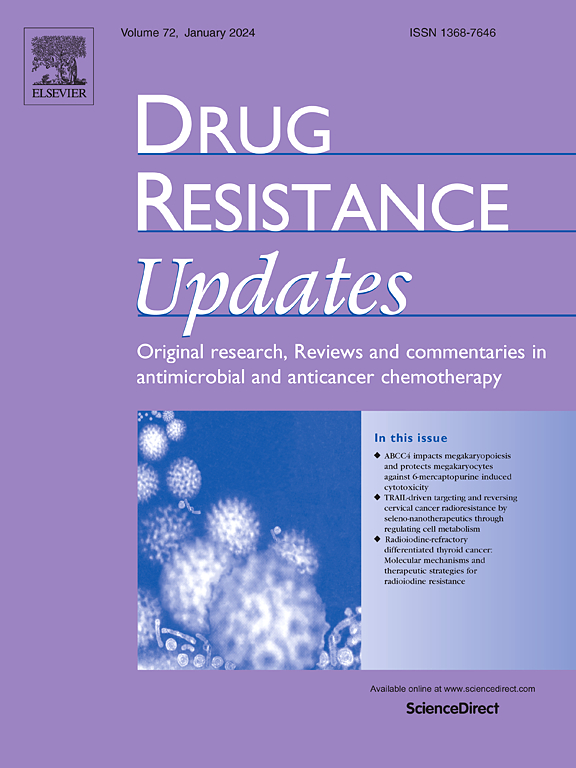长链非编码RNA LRTOR通过促进YAP正反馈回路驱动非小细胞肺癌的奥西替尼耐药
IF 15.8
1区 医学
Q1 PHARMACOLOGY & PHARMACY
引用次数: 0
摘要
奥西替尼(OSI)治疗egfr突变型肺癌的疗效最终受到获得性耐药的限制,其机制尚不清楚。在这里,我们发现了一种新的长链非编码RNA LRTOR,作为非小细胞肺癌(NSCLC)中OSI耐药的关键驱动因素。临床资料表明,在osi耐药患者中,LRTOR表达升高与预后不良相关。在功能上,LRTOR促进肿瘤生长,并在体外和体内赋予OSI抗性。在机制上,LRTOR保护YAP免受lats介导的Ser127和Ser381磷酸化,阻止其蛋白酶体降解。此外,LRTOR促进了YAP与KCMF1之间的相互作用,促进了k63连锁的泛素化、YAP的核易位和YAP/TEAD1转录复合物的形成,而YAP/TEAD1转录复合物反过来又触发了LRTOR的转录,建立了一个正反馈回路,放大了YAP的致癌信号,从而诱导了OSI抗性。在患者来源的类器官异种移植模型中证实,siRNA耗尽LRTOR可恢复耐药肿瘤的OSI敏感性。我们的研究结果揭示了LRTOR是NSCLC中OSI耐药的中心调节因子,并提出它是克服egfr突变肺癌获得性OSI耐药的有希望的治疗和预后靶点。本文章由计算机程序翻译,如有差异,请以英文原文为准。
Long non-coding RNA LRTOR drives osimertinib resistance in non-small cell lung cancer by boosting YAP positive feedback loop
The therapeutic efficacy of osimertinib (OSI) in EGFR-mutant lung cancer is ultimately limited by the onset of acquired resistance, of which the mechanisms remain poorly understood. Here, we identify a novel long non-coding RNA, LRTOR, as a key driver of OSI resistance in non-small cell lung cancer (NSCLC). Clinical data indicate that elevated LRTOR expression correlates with poor prognosis in OSI-resistant patients. Functionally, LRTOR promotes tumor growth and confers OSI resistance both in vitro and in vivo . Mechanistically, LRTOR shields YAP from LATS-mediated phosphorylation at Ser127 and Ser381, preventing its proteasomal degradation. Furthermore, LRTOR facilitates the interaction between YAP and KCMF1, promoting K63-linked ubiquitination, nuclear translocation of YAP, and formation of the YAP/TEAD1 transcriptional complex, which in turn triggers the transcription of LRTOR, establishing a positive feedback loop that amplifies oncogenic signaling of YAP and consequently induces OSI resistance. LRTOR depletion by siRNA restores OSI sensitivity in resistant tumors, as demonstrated in patient-derived organoid xenograft models. Our findings unveil LRTOR as a central regulator of OSI resistance in NSCLC and propose it as a promising therapeutic and prognostic target for overcoming acquired OSI resistance in EGFR-mutant lung cancer.
求助全文
通过发布文献求助,成功后即可免费获取论文全文。
去求助
来源期刊

Drug Resistance Updates
医学-药学
CiteScore
26.20
自引率
11.90%
发文量
32
审稿时长
29 days
期刊介绍:
Drug Resistance Updates serves as a platform for publishing original research, commentary, and expert reviews on significant advancements in drug resistance related to infectious diseases and cancer. It encompasses diverse disciplines such as molecular biology, biochemistry, cell biology, pharmacology, microbiology, preclinical therapeutics, oncology, and clinical medicine. The journal addresses both basic research and clinical aspects of drug resistance, providing insights into novel drugs and strategies to overcome resistance. Original research articles are welcomed, and review articles are authored by leaders in the field by invitation.
Articles are written by leaders in the field, in response to an invitation from the Editors, and are peer-reviewed prior to publication. Articles are clear, readable, and up-to-date, suitable for a multidisciplinary readership and include schematic diagrams and other illustrations conveying the major points of the article. The goal is to highlight recent areas of growth and put them in perspective.
*Expert reviews in clinical and basic drug resistance research in oncology and infectious disease
*Describes emerging technologies and therapies, particularly those that overcome drug resistance
*Emphasises common themes in microbial and cancer research
 求助内容:
求助内容: 应助结果提醒方式:
应助结果提醒方式:


